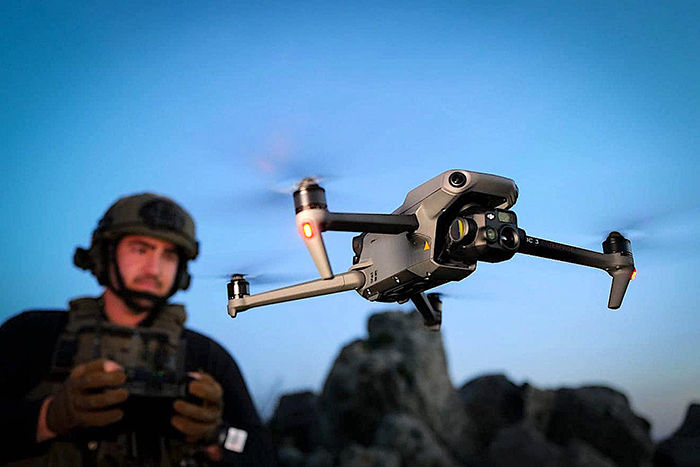Israeli soldier operates a drone in the Golan Heights, Feb. 11, 2024. Photo courtesy of Michael Giladi/Flash90.
JNS
By now, most of us have seen the video. Hamas leader Yahya Sinwar, battered, broken, wounded, coated in dust, draped in a chair as a surveillance drone flies into the remains of a building to locate him. With his working arm, he throws a piece of wood at the drone before it retreats and Israeli forces come in to eliminate Public Enemy No. 1, the mastermind of the massacre in southern Israel on Oct. 7, 2023.
At a recent gathering, one of the soldiers involved in the operation told Jessica Zandani: “We killed Sinwar.”
“Yes, I know,” she replied.
Epiphany
“No, you don’t understand,” the soldier said. He pointed at her then back at himself, and said, “We killed Sinwar.” Suddenly, it dawned on her—the drone that had spotted Sinwar, that he had tried to bring down with a stick, was one of the ones donated and maintained thanks to her and the donors she has worked with.
According to IDF Sgt. O, one of the commanders of the unit whose combat team eliminated Sinwar, these donated drones are key to helping the division achieve its operational goals and save many lives.
Drones Key
Drones have become integral to warfare on both sides of the conflict. Recently, for instance, an enemy drone laden with rifles was intercepted after crossing the Israeli border from Egypt.
Drone operators are active members of many army units, with observation drones protecting the force from above and safeguarding the soldiers, while surveillance drones enter houses and tunnels ahead of troops to identify booby traps or terrorists in hiding. Some are equipped with specialized cameras, with sensors capable of thermal imaging, allowing them to pinpoint anyone who may be camouflaged or hiding, or aiding in identifying possible captives or remains. Thermal imaging is crucial for search and rescue operations.
Zandani and business partner Shai Spetgang, a licensed drone pilot and trainer as well as an inventor and businessman, have developed a program called STEM-Up Israel with other nonprofit organizations to create a system for procuring, building, lending and maintaining drones for the army.
“Drones perform not only surveillance,” said Prof. Pavel Ginzburg, head of Dynamics of Nanostructures Laboratory Electrical Engineering at Tel Aviv University. “Missions can be defense, attack, data collection, deception, connectivity, logistics and more.”
They range in size from micro-craft to wingspans of 10 meters and more.
Chinese Connection
Due to the complexities of importing equipment that may also have military uses, a few non-profit groups have been authorized to import dual-purpose drones, weighing under 4.5 kilograms, by the Israeli Communications Ministry. These drones are made primarily for photography, marketing and recreational consumer use.
According to Ginzburg, while there are many companies and manufacturers, China leads the consumer market. While other countries manufacture drones, China’s are much less expensive, making them cost-effective, although not the best solution for an army that needs many drones. There is a scarcity of American-made consumer drones, although they do manufacture “enterprise” drones, expensive machines designed for large businesses.
“Most companies in China have a connection to the Chinese government, which for example established DJI, which has cornered the consumer market,” Spetgang explained. “Another popular brand, Autel, has drones assembled in the United States with Chinese parts.”
Must Be Rebuilt
That, according to Zandani, is a huge problem. For one thing, Chinese drones are subject to embargoes and increased tariffs because China considers itself an ally of Israel’s arch-enemy, Iran. Then, as with many Chinese government-produced electronics, there are data security issues. To make a Chinese drone safe for use, both the drone and the remote that operates it must be completely stripped and rebuilt. Using off-the-shelf drones is dangerous to both the drones, which can be hijacked and hacked by enemies, and the soldiers who operate them.
The Israeli military is thus left with a conundrum. While drones are an indisputable part of the platoon, and prevent soldiers from inadvertently entering terrorist booby traps and ambushes, drones used by soldiers must be customized for army purposes and maintained meticulously. Just as soldiers must be in constant communication, ideally, all IDF drones should synchronize with others as well.
Zandani explained that military operations generally use a combination of drones. Larger ones function as overhead sentries, part of an all-in-one system with jamming and anti-jamming capabilities. A few retrofitted Chinese DJI Avata drones complete the drone team, and the operators coordinate the operation with nearby tanks and ground soldiers.
Drones Could Save Life
The refurbished, mostly donated Chinese drones, made for photographers, hobbyists and architects, have a high failure rate. Furthermore, each drone requires a constant supply of batteries.
“When they fall or when they are hit, they are knocked out of service,” Zandani elaborated. “Currently, it takes a lot of time and money to repair and restore them. In a normal military scenario, we’re losing 20% to 30% of our drones each day. In wartimes, a bad day can translate into a 50% to 60% loss.”
STEM-up Israel has set out to solve the challenges posed by the current situation on the ground.
For one, currently, nonprofit organizations are prohibited from granting tax exemptions in the United States for anything that could be used for military purposes, except for basic sundries. The prohibited items include but are not limited to drones, as well as combat gear and other items.
“I only know of about 700 Evos in the field that were not donated,” explains Zendani. “The vast majority of drones used by the IDF are donated. Since the beginning of the war, along with other nonprofits we have worked to raise over $20 million for the purchase of drones, batteries, flymore kits, etc., and we can always use more because we know that every drone saves lives.”
This, she said, is Israel’s “World War I moment” with regard to drones. “It is as if we have horses on the ground and planes in the air. We know that our boys in the field are not dumb, we know that they don’t want to go in if they don’t have the right gear to protect them and allow them to come home safely to their families. We know of soldiers who have died because they didn’t have drones. We also know of entire units who have refused to go in and were actually arrested because they refused to go in without drones.”
One aspect of STEM-up Israel is a program to train high school students, beginning in Zandani’s local high school in Be’er Tuvia, to build, operate, repair and create new generations of drones. Through this program, which she hopes to roll out to schools throughout Israel, she will procure drone parts, and use volunteer engineers to teach the youth. She will also offer their services to repair downed drones and refurbish them for army use and will loan them out to civilian patrol teams (Kitat Konenut), to the army for training and operations and to search and rescue groups.
An immigrant from Santa Monica, Calif., Zandani is no stranger to the NGO world and was never one to sit on the sidelines during times of need. Before Oct. 7, 2023, she was ready to launch an organization called “Little Hands” to create safe interactive spaces for special needs children affected by the intermittent barrages of rockets to “the forty-kilometer zone” near Gaza.
Living in a moshav in the south, she explained that the explosions that can be heard from Gaza and the thunderous sounds of incoming rockets hitting the Gaza Envelope were especially unsettling for Special-Ed. children.
She raised money with support from Rep. Buddy Carter of Georgia and built a soundproof room—like an orchestra practice room—to shelter children from traumatic sounds. Set to launch mid-October 2023, the plans fell through after the October massacre, when most safe room designs were completely reassessed in the wake of Hamas’s invasion.
‘People Wanted To Give’
Responding to an evacuation order from the U.S. Congress, Zandani and her children fled amid the sirens and rockets. Her husband stayed behind to fight. In the United States, she went on a massive campaign to bring the realities of Israel’s brutalized south to broadcast news outlets.
“When I got back to my extended family—most of whom were in the army—all my friends from the United States were asking how they could help,” she recalled. She knew she would have to “pivot” to somehow help while her other idea was on hold, and she did some research.
“I realized that there was a huge breakdown in what soldiers actually needed and how it was getting to where it needed to be. People wanted to give; they knew we needed help, and many were giving large donations to organizations, thinking they were buying necessities and gear for soldiers. But, boots on the ground, the numbers weren’t translating into actual gear, unless you count flip-flops and chocolate for lone soldiers.”
As a mom who worked as a kindergarten teacher she had learned that the more eyes in the sky, the safer everyone was.
“I realized that … no one was really focusing on drones,” explained Zandani. “I was looking at it from a vantage point of how do we keep our soldiers from entering dangerous situations, and the answer boiled down to surveillance drones. Besides helmets and vests, which are also still needed badly, drones are very necessary.”
She began procuring drones for a new “drone school” for the IDF Southern Command.
Commander G, who heads the school, explained, “We train both enlisted soldiers and reservists in flying the drones. Half a day they fly the drones with instructors and the other half they learn about the app to control the drones, handling the remote, safe deployment in the field and troubleshooting if something goes wrong. We also teach the different methods for flying drones in open fields, buildings and tunnels.”
Recently the school hosted a search and rescue unit, teaching them drone usage for recovery of remains in a battle situation.
“Imagine the difference it would have made to search and rescue on Oct. 7,” said Zandani. “At the time they were forced to enter a dangerous, battle-ridden situation to hunt for bodies. The drones could have been the first responders, once again saving lives and helping with search and rescue efforts.”
By joining forces with the defense, education and communication ministries, and others, “The hope is that we can fully realize the lifesaving potential, and create new technology, systems and uses for the hero drones of the IDF through STEM-Up Israel,” she said.








